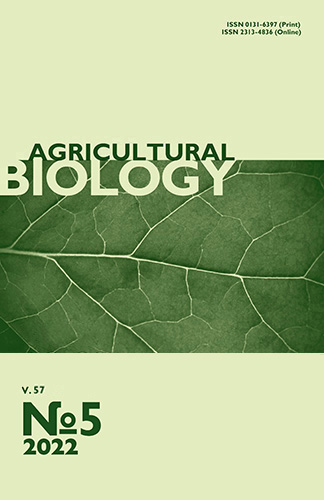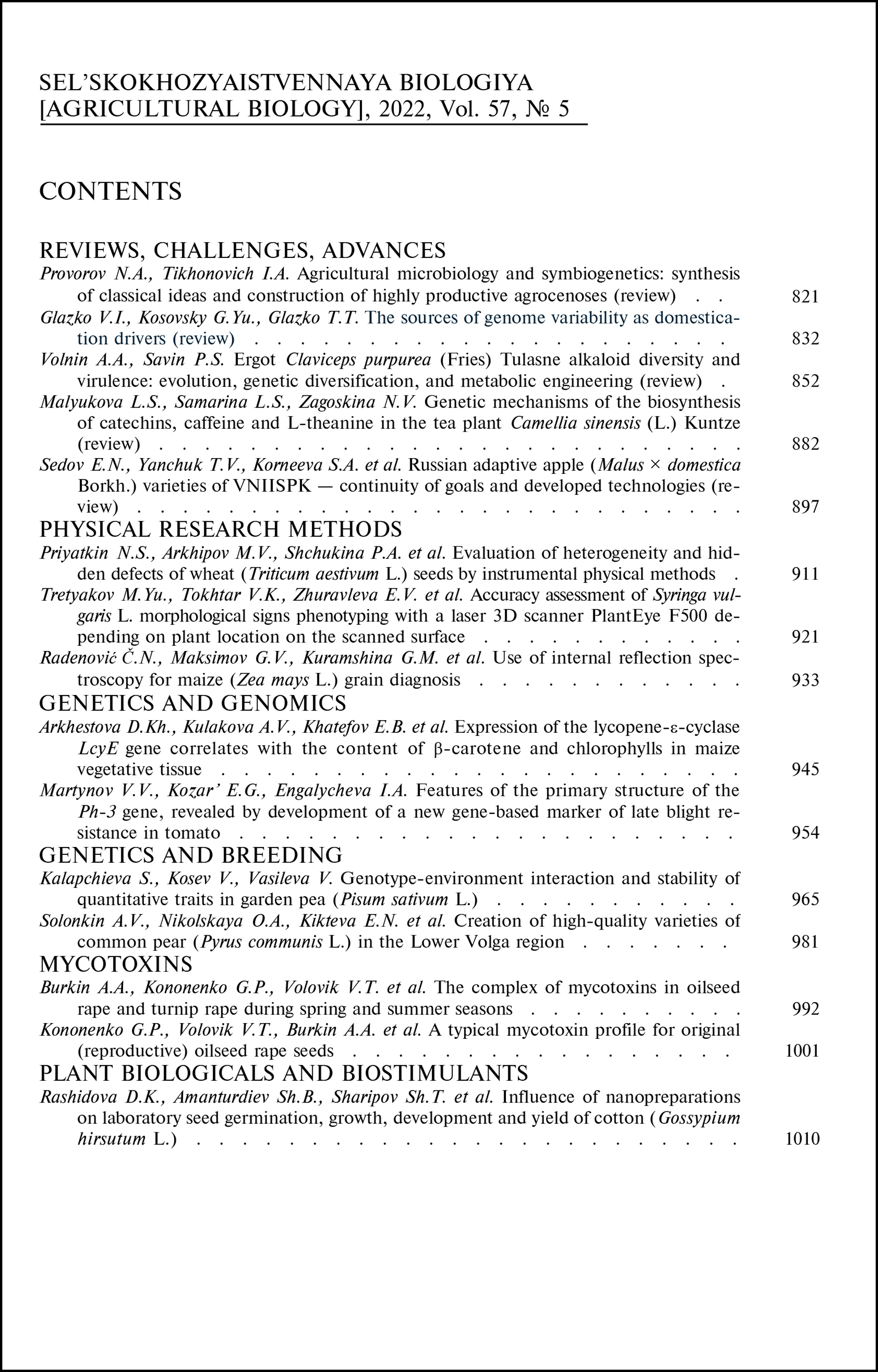doi: 10.15389/agrobiology.2022.5.1001eng
UDC: 633.85:581.192.6:579.222:543.9
Acknowledgements:
The authors are grateful to E.A. Piryazeva (the Laboratory of Mycotoxicology and Feed Sanitation, All-Russian Research Institute of Veterinary Sanitation, Hygiene and Ecology) for performing mycological analysis and assistance in searching scientific literature.
The work was carried out within the framework of the cooperation agreement between the Federal Scientific Center Williams VIK and VNIIVSGE — Branch of the Federal Scientific Center VIEV RAS (dated March 17, 2021).
A TYPICAL MYCOTOXIN PROFILE FOR ORIGINAL (REPRODUC-TIVE) OILSEED RAPE SEEDS
G.P. Kononenko1 ✉, V.T. Volovik2, A.A. Burkin1, S.E. Sergeeva2
1All-Russian Research Institute of Sanitary, Hygiene and Ecology — Branch of FSC ARRIEV RAS, 5, Zvenigorodskoe sh., Moscow, 123022 Russia, e-mail aaburkin@mail.ru, kononenkogp@mail.ru (✉ corresponding author);
2Williams Federal Research Center for Fodder Production and Agroecology, 1, Nauchnii Gorodok, Lobnya, Moscow Province, 141055 Russia, e-mail vik_volovik@mail.ru, mesvetlanka@mail.ru
ORCID:
Burkin A.A. orcid.org/0000-0002-5674-2818
Volovik V.T. orcid.org/0000-0002-8966-4457
Kononenko G.P. orcid.org/0000-0002-9144-615X
Sergeeva S.E. orcid.org/0000-0002-4244-8183
Received May 7, 2022
For rapeseed, the world’s third largest source of vegetable oil, there are special requirements for post-harvest processing, which are rapid drying to the required moisture content due to the threat of mass mold during storage (J.T. Mills, 1987; J.T. Mills, R.N. Sinha, 1980). The authors of publications explained all known cases of mycotoxin detection in seeds of this crop by either infection of plants in the field or by the impact of unfavorable factors during harvesting (I. Brazauskiene et al., 2006; A. Mankeviciene et al., 2011, L. Wu et al., 2017). In this study, for the first time, we have confirmed that the presence of toxic metabolites of fungi of the genera Fusarium, Alternaria, Penicillium, Aspergillus, Myrothecium and a number of others is not typical for seeds of this crop. The purpose of this work was mycotoxicological examination of oilseed rape Brassica napus L. ssp. oleifera (Metzg.) Sinsk seeds under proper phytosanitary and technological conditions during cultivation, harvesting and storage. Original (reproduction) seeds were harvested in 2009-2021 from experimental plots (the Laboratory of fodder crops and field feed production systems, the Williams Federal Research Center, Moscow Province). After grinding in a laboratory mill, 158 samples were analyzed by a unified methodology using certified commercial and research enzyme immunoassay test systems (GOST 31653–2012). For extraction, a mixture of acetonitrile and water was used (84:16 v/v), 5 ml per 1 g sample. Mycotoxins (T-2 toxin, deoxynivalenol, zearalenone, fumonisins of group B, ergot alkaloids, alternariol, roridin A, aflatoxin B1, sterigmatocystin, cyclopiazonic acid, emodin, ochratoxin A, citrinin, mycophenolic acid, PR-toxin) were determined in extracts after 10-fold dilution with phosphate-salt buffer solution (pH 7.4) with Tween 20. The analyzed mycotoxins were not found in the seeds of the 2009-2020 harvests collected under normal weather conditions and without violations of the drying and storage regimes. For only one sample of spring rapeseed (Bison variety, 2019), weak contamination with mycophenolic acid was detected and the producer Aspergillus pseudoglaucus Blochwitz was identified in the mycobiota. In the seeds of the 2021 harvested under elevated temperature and humidity, contamination with ergot alkaloids (from 2 to 12 μg/kg = ppb) was found in 67.5 % of spring and 25.6 % of winter crops. In addition, 28.6 % of spring rape samples contained alternariol, mainly in low concentrations (from 8 to 32 ppb) and rarely with a more pronounced accumulation (from 46 to 775 ppb). In one spring rapeseed sample which was stored in an under-dried state for the longest time, the greatest contamination with alternariol occurred and intensive infection with the fungus Alternaria tenuissima (Nees et T. Nees:Fries) Wiltshire were determined with an experimentally confirmed ability to toxin formation.
Keywords: oilseed rape, seeds, mycotoxins, enzyme immunoassay.
REFERENCES
- Federal’nyy tsentr razvitiya еksporta produktsii APK Minsel’khoza Rossii. Obzor VЕD: rapsovoe maslo [Overview of foreign economic activity: rapeseed oil]. Available: https://aemcx.ru/2021/11/23/obzor-vеd-rapsovoe-maslo/. Accessed: 4.10.2021 (in Russ.).
- Mills J.T., Sinha R.N., Wallace H.A.H. Assessment of quality criteria of stored rapeseed — a multivariate study. Journal of Stored Products Research, 1978, 14(2-3): 121-133 CrossRef
- Mills J.T., Sinha R.N. Safe storage periods for farm-stored rapeseed based on mycological and biochemical assessment. Phytopathology, 1980, 70(6): 541-547 CrossRef
- Tabuc K., Stefan G. Assessment of mycologic and mycotoxicologic contamination of soybean, sunflower and rape seeds and meals during 2002-2004. Archiva Zootechnika, 2005, 8: 51-56.
- Şesan T.E., Groza O. Mycobiota of rape seeds in Romania. I. Identification of mycobiota associated with rape seeds from different areas of Romania. Acta Mycologica, 2013, 48(2): 263-277 CrossRef
- Kačergius K., Lugauskas A., Levinskaite L., Varnaite R., Mankevičiene A., Bakutis B., Baliukoniene V., Brűkštiene D. Screening of micromycetes producing toxic substances under various conditions. Botanica Lithuanica, 2005, 7: 65-75.
- Brazauskiene I., Petraitiene E. The occurrence of Alternaria blight (Alternaria spp.) and Phoma stem canker (Phoma lingam) on oilseed rape in central Lithuania and pathogenic fungi on harvested seed. Journal of Plant Protection Research, 2006, 46(3): 295-311.
- Frḁs M., Jezierska-Tys S., Tys J. Populations of selected mictobial and fungal species growing on the surface of rape seeds following treatment with desiccants or plant growth regulators. Journal of Toxicology and Environmental Health, Part A, 2010, 73(17-18): 1230-1235 CrossRef
- Tańska M., Konopka I., Korzeniewska E., Rotkiewicz D. Colour of rapeseed (Brassica napus) surface and contamination by fungi during storage of dry and wet seeds. International Journal of Food Science & Technology, 2011, 46(11): 2265-2273 CrossRef
- Škrinjar M.M., Miklič V.J., Kocić-Tanackov S.D., Marjanović A.M., Maširevic S.N., Suturović I.Z., Blagojev N.T., Šošo V.M. Xerophilic mycopopulations isolated from rapeseeds (Brassica napus). APTEFF (ActaPeriodicaTechnologica), 2013, 44: 115-124 CrossRef
- Maširević S., Feldeždi M., Škrinjar M., Kocić-Tanackov S., Radujkov D. First report of Acremonium charticola (Lindau) W. Gams on rapeseed samples in storage during 2012 in Serbia. Research Journal of Agricultural Science, 2014, 46 (2): 178-181.
- Jeswal P. Occurrence of mycotoxins in oil seeds of Bihar State (India) and post-harvest storage suitability for minimization of mycotoxins in oil seeds and its products. Proc. ISM Conf. «Worldwide mycotoxin reduction in food and feed chain». Tulln, 2009: 43.
- Bhat R., Reddy K. Challenges and issues concerning mycotoxin contamination in oil seeds and their edible oils: updates from last decade. Food Chemistry, 2017, 215: 425-437 CrossRef
- Kesho A., Abebe W. Major fungi associated with some cereals, oils and legume crops of seeds grown in main season at Holetta Agricultural Research Center by seed technology multiplication (HARC, EIAR). International Journal of Multidisciplinary Sciences and Advanced Technology, 2021, 2(6): 48-53.
- Brazauskienė I., Petraitienė E., Mankevičienė A. Effects of genotype and environmental factors on rapeseed contamination with mycotoxins and mycotoxin-producing fungi. Ecologija, 2006, 3: 14-20.
- Mankeviciene A., Suproniene S., Brazauskiene I., Gruzdeviene E. Natural occurrence of Fusarium mycotoxins in oil crop seed. Plant Breeding and Seed Science, 2011, 63: 109-116 CrossRef
- Kowalska G., Kowalski R. Occurrence of mycotoxins in selected agricultural and commercial products available in eastern Poland. Open Chemistry, 2021, 19(1): 653-664 CrossRef
- Kozlovskiy A.G. Prikladnaya biokhimiya i mikrobiologiya, 1999, 35(5): 536-545 (in Russ.).
- Viñas I., Palma J., Garza S., Sibilia A., Sanchis V., Visconti A. Natural occurrence of aflatoxin and Alternaria mycotoxins in oilseed rape from Catalonia (Spain) — incidence of toxigenic strains. Mycopathologia, 1994, 128(3): 175-179 CrossRef
- Zhang Q., Zhang J., Yang L., Zhang L., Jiang D., Chen W., Li G. Diversity and biocontrol potential of endophytic fungi in Brassica napus. Biological Control, 2014, 72: 98-108 CrossRef
- Zotova E.V., Kononenko G.P., Burkin A.A. V sbornike: Sovremennaya mikologiya v Rossii [In: Modern mycology in Russia]. Moscow, 2017, 7: 202-204 (in Russ.).
- Kononenko G.P., Zotova E.V., Ustyuzhanina M.I.V sbornike: Uspekhi meditsinskoy mikologii [In: Advances in medical mycology]. Moscow, 2019, 20: 649-653 (in Russ.).
- Burkin A.A., Kononenko G.P. Izvestiya RAN. Seriya biologicheskaya, 2022, 3: 237-245 (in Russ.).
- Burkin A.A., Kononenko G.P., Mosina L.V. The first mycotoxicological investigation of white mustard (Sinapis alba L.). Agricultural Biology, 2019, 54(1): 186-194 CrossRef
- Kusari S., Spiteller M. Metabolomics of endophytic fungi producing associated plant secondary metabolites: progress, challenges and opportunities In: Metabolomics. U. Roessner (ed.). InTech, London, 2012: 241-266.
- Winter M., Koopmann B., Döll K., Karlovsky P., Kropf P., Schlüter K., von Tiedemann A. Mechanisms regulating grain contamination with trichothecenes translocated from the stem base of wheat (Triticum aestivum) infected with Fusarium culmorum. Phytopathology, 2013, 103(7): 682-689 CrossRef
- Saharan G.S., Mehta N., Meena P.D. Alternaria diseases of crucifers: biology, ecology and disease management. Springer Science+Business Media Singapore, 2016 CrossRef
- Gannibal F.B., Gasich E.L. Mikologiya i fitopatologiya, 2009, 43(5): 447-456 (in Russ.).
- Wu L., Zhou H., Zhu T., Yang H., Dong X., Chen L., Bai Y., Yin N., Ding X., Li P. Fungal diversity and mycotoxin identification of mouldy rapeseed in China. Oil Crop Science, 2017, 2(1): 38-48 CrossRef
- USDA. Godovoy otchet maslichnym i produktam pererabotki v Rossii [USDA. Annual report on oilseeds and by-products in Russia]. Available: https://www.zol.ru/n/33b4c. Accessed: 15.02.2022 (in Russ.).
- Pakhomova O.N. Razrabotka i ispol’zovanie funktsional’nogo pishchevogo obogatitelya iz zhmykha rapsovogo. Kandidatskaya dissertatsiya [Development and use of a functional food fortifier produced from rapeseed cake. PhD Thesis]. Orel, 2014 (in Russ.).












